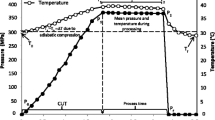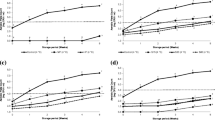Abstract
Physical and nutritional attributes of aonla juice treated with hydrodynamic cavitation (HC) at a pressure range of 5–15 psi and time between 5 to 30 min were evaluated. Based on maximum retention of bioactives, antioxidant activity, inactivation of polyphenol oxidase (PPO), and physicochemical properties, HC conditions were optimized at 10 psi for 15 min, based on retention of 92.19% antioxidant activity, 88.01% vitamin C, and 96.80% of total phenolic content. Improved sedimentation index and viscosity were noted due to HC processing. The color profile of HC-treated samples was improved with less browning (63.86) and yellowing index (14.79) than that of control (browning index 64.61). Thermally treated samples inactivated 100% of PPO at 95 ℃ for 3 min, however, formation of a dark color with a browning index value of 67.38 was noted. The retention of various bioactives in thermally treated juice samples was much lesser than that of HC-treated samples.

Similar content being viewed by others
Data availability
Research data are not shared.
References
Anonymous. Amla extract market analysis report by type, by application and segment forecasts from 2019 to 2025, Grand View Research Inc.CA, USA. (2020) Retrieved from: https://www.millioninsights.com/industry-reports/global-amla-extract-market
Arya SS, More PR, Terán Hilares R, Pereira B, Arantes V, da Silva SS. Santos JC. Effect of thermally assisted hydrodynamic cavitation (HC) processing on physical, nutritional, microbial quality, and pectin methyl esterase (PME) inactivation kinetics in orange juice at different time and temperatures. Journal of Food Processing and Preservation. 45: 1–18 (2021)
Halliwell B. Vitanin C: Antioxidant or pro-oxidant in vivo? Free Radical Research. 25:439–45 (1996)
Belitz HD, Grosch W, Schieberle P. Fruits and fruit products. Food Chemistry. 806–861 (2004)
Bhattacherjee AK, Tandon DK, Dikshit A, Kumar S. Effect of pasteurization temperature on quality of aonla juice during storage. Journal of Food Science and Technology. 48: 269–273 (2011)
Chakraborty S, Ghag S, Bhalerao PP, Gokhale JS. The potential of pulsed light treatment to produce enzymatically stable Indian gooseberry (Emblica officinalis Gaertn.) juice with maximal retention in total phenolics and vitamin C. Journal of Food Processing and Preservation. 44: 0–2 (2020)
Cserhalmi Z, Sass-Kiss Á, Tóth-Markus M, Lechner N. Study of pulsed electric field treated citrus juices. Innovative Food Science and Emerging Technologies. 7: 49–54 (2006)
Hart EJ, Henglein A. Free radical and free atom reactions in the sonolysis of aqueous iodide and formate solutions. Journal of Physical Chemistry. 89: 4342-4347 (1985)
Hiwale S. Value addition in underutilized fruits. In: Sustainable horticulture in semiarid dry lands. Springer, New Delhi (2015). https://doi.org/10.1007/978-81-322-2244-6_30
Jat ML, Shivran JS, Jat RK, Pragati. Commercial products of aonla fruits, increasing the value addition. Journal of Pharmacognosy and Phytochemistry. 10: 1331–1337 (2021)
Katariya P, Arya SS, Pandit AB. Novel, nonthermal hydrodynamic cavitation of orange juice: Effects on physical properties and stability of bioactive compounds. Innovative Food Science and Emerging Technologies. 62: 102364 (2020)
Kubo MTK, Augusto PED, Cristianini M. Effect of high pressure homogenization (HPH) on the physical stability of tomato juice. Food Research International. 51: 170–179 (2013)
Landl A, Abadias M, Sárraga C, Viñas I, Picouet PA. Effect of high pressure processing on the quality of acidified Granny Smith apple purée product. Innovative Food Science and Emerging Technologies. 72: 102742 (2010)
Leite TS, Augusto PED, Cristianini M. Using high pressure homogenization (HPH) to change the physical properties of cashew apple juice. Food Biophysics. 10: 169–180 (2015)
Manzocco L, Panozzo A, Nicoli MC. Inactivation of polyphenoloxidase by pulsed light. Journal of Food Science. 78: E1183-E1187 (2013)
Martynenko A, Chen Y. Degradation kinetics of total anthocyanins and formation of polymeric color in blueberry hydrothermodynamic (HTD) processing. Journal of Food Engineering. 152: 8-16 (2016)
Mayachiew P, Devahastin S. Antimicrobial and antioxidant activities of Indian gooseberry and galangal extracts. LWT - Food Science and Technology. 41(7): 1153–1159 (2008)
Milly PJ, Toledo RT, Kerr WL, Armstead D. Hydrodynamic cavitation: Characterization of a novel design with energy considerations for the inactivation of Saccharomyces cerevisiae in apple juice. Journal of Food Science. 73: M298-M303 (2008)
National Horticulture Board. State-wise area and production of aonla. In Horticultural statistics at a glance 2018. Horticulture Statistics Division, Ministry of Agriculture & Farmers' Welfare, Government of India. (2018). Retrieved from: http://nhb.gov.in/statistics/Publication/Horticulture%20Statistics%20at%20a%20Glance 2018.pdf
Nayak P, Tandon DK, Bhatt DK, Kanshi MS, Ji R. Study on changes of nutritional and organoleptic quality of flavored candy prepared from aonla (Emblica officinalis G.) during storage. International Journal of Nutrition and Metabolism. 4: 100–106 (2012)
Nisha P, Shinghal RS, Pandit AB. A study on degradation kinetic of ascorbic acid in amla (Phyllanthus emblica L.) during cooking. International Journal of Food Sciences and Nutrition. 55: 415–422 (2004)
Oey I, Verlinde P, Hendrickx M, Van Loey A. Temperature and pressure stability of L-ascorbic acid and/or [6s] 5-methyltetrahydrofolic acid: A kinetic study. European Food Research and Technology. 223: 71-77 (2006)
Parveen K, Khatkar BS. Physico-chemical properties and nutritional composition of aonla (Emblica officinalis) varieties. International Food Research Journal. 22: 2358–2363 (2015)
Pétrier C, Combet E, Mason T. Oxygen-induced concurrent ultrasonic degradation of volatile and non-volatile aromatic compounds. Ultrasonics Sonochemistry. 15: 117-121 (2007)
Pinheiro J, Alegria C, Abreu M, Gonçalves EM, Silva CLM. Influence of postharvest ultrasounds treatments on tomato (Solanum lycopersicum, cv. Zinac) quality and microbial load during storage. Ultrasonics Sonochemistry. 27: 552–559 (2015)
Raj AS, Chakraborty S, Rao PS. Thermal assisted high-pressure processing of Indian gooseberry (Embilica officinalis L.) juice – Impact on colour and nutritional attributes. LWT- Food Science and Technology. 99: 119–127 (2019)
Jambrak AR, Šimunek M, Evačić S, Markov K, Smoljanić G, Frece J. Influence of high power ultrasound on selected moulds, yeasts and Alicyclobacillus acidoterrestris in apple, cranberry and blueberry juice and nectar. Ultrasonics. 83: 3-17 (2018)
Rabie MA, Soliman AZ, Diaconeasa ZS, Constantin B. Effect of pasteurization and shelf life on the physicochemical properties of Physalis (Physalis peruviana L.) juice. Journal of Food Processing and Preservation. 39:1051–1060 (2015)
Rojas ML, Leite TS, Cristianini M, Alvim ID, Augusto PED. Peach juice processed by the ultrasound technology: Changes in its microstructure improve its physical properties and stability. Food Research International. 82: 22–33 (2016)
Sampath Kumar KP, Bhowmik D, Dutta A, Yadav AP, Paswan S, Srivastava S, Deb L. Recent trends in potential traditional indian herbs Emblica Officinalis and its medicinal importance. Journal of Pharmacognosy and Phytochemistry.1: 18-28 (2012)
Seshadri R, Weiss J, Hulbert GJ, Mount J. Ultrasonic processing influences rheological and optical properties of high-methoxyl pectin dispersions. Food Hydrocolloids. 17: 191-197 (2003)
Terán Hilares R, dos Santos JG, Shiguematsu NB, Ahmed MA, da Silva SS, Santos JC. Low-pressure homogenization of tomato juice using hydrodynamic cavitation technology: Effects on physical properties and stability of bioactive compounds. Ultrasonics Sonochemistry. 54: 192–197 (2019)
Tiwari BK, Muthukumarappan K, O' Donnell CP, Cullen PJ. Modelling colour degradation of orange juice by ozone treatment using response surface methodology. Journal of Food Engineering. 88: 553–560 (2008)
Vigneshwaran G, More PR, Arya SS. Nonthermal hydrodynamic cavitation processing of tomato juice for physicochemical, bioactive, and enzyme stability: Effect of process conditions, kinetics, and shelf-life extension. Current Research in Food Science. 5: 313–324 (2022)
Yu W, Cui J, Zhao S, Feng L, Wang Y, Liu J, Zheng J. Effects of high-pressure homogenization on pectin structure and cloud stability of not-from-concentrate orange juice. Frontiers in Nutrition. 8: 647748 (2021)
Acknowledgements
The authors thank All India Council for Technical Education (AICTE), New Delhi for the financial support in carrying out the study
Author information
Authors and Affiliations
Contributions
RPA: Conceptualization, Formal analysis, Investigation, Writing—original draft PRM: Formal analysis, Writing—review & editing, Visualization, Supervision. SSA: Conceptualization, Writing—review & editing, Visualization, Supervision.
Corresponding author
Ethics declarations
Conflict of interest
The authors declare that they have no direct or indirect known competing financial interests or personal relationships that could have appeared to influence the subject matter discussed and reported in this paper.
Additional information
Publisher's Note
Springer Nature remains neutral with regard to jurisdictional claims in published maps and institutional affiliations.
Supplementary Information
Below is the link to the electronic supplementary material.
Rights and permissions
Springer Nature or its licensor holds exclusive rights to this article under a publishing agreement with the author(s) or other rightsholder(s); author self-archiving of the accepted manuscript version of this article is solely governed by the terms of such publishing agreement and applicable law.
About this article
Cite this article
Annapoorna, R.P., More, P.R. & Arya, S.S. Effect of pressure and time on bioactive content, PPO inactivation, physicochemical and sensory properties of aonla (Emblica officinalis) juice during hydrodynamic cavitation processing. Food Sci Biotechnol 32, 71–82 (2023). https://doi.org/10.1007/s10068-022-01164-2
Received:
Revised:
Accepted:
Published:
Issue Date:
DOI: https://doi.org/10.1007/s10068-022-01164-2




